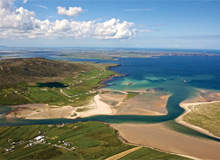
The Corrib Natural Gas Field is situated approximately 83km off the County Mayo coast in Ireland, in a water depth of 350m. The Corrib reservoir is located at a further distance of 3,000m from the seabed. Discovered in 1996, the field comprises high-purity natural gas with traces of hydrocarbon liquids and water.
The field is being developed by Shell E&P Ireland (SEPIL), who is the operator, Statoil and Vermilion Energy. Five wells have been completed and made ready for production.
Gas from the field will be processed at the Bellanaboy Bridge Terminal, located approximately 9km inland. By August 2009, the terminal was 90% constructed and has been connected to the Bord Gáis Éireann (BGE) national grid.
Pipeline connection
The field is connected to the Bellanaboy Bridge Terminal via a 90km long pipeline, of which 83km is located offshore connecting the field’s wells to the landfall at Glengad. The onshore section is completely underground throughout its route.
The wall of the 20in diameter pipeline is more than one inch thick and is made entirely of high-grade carbon steel. Multiple layers of the plastic and concrete coating protect the pipeline externally.
Internal protection is provided by a corrosion inhibitor that is injected continuously from the umbilical. Data on the internal condition of the pipeline is collected through a smart pig internal inspection tool. The pipeline can withstand up to 345 bar pressure. During normal conditions, it will operate at pressures of 90–110 bar, which will gradually reduce as the gas on the reservoir begins to deplete.
Bellanaboy Bridge gas processing
The Bellanaboy Bridge terminal is designed to process 10 million cubic metres of gas per day and will operate 24 hours a day. Small amounts of liquid, partially in vapour form, will be removed from the gas at the terminal before it is distributed to the BGÉ grid. Before being transferred to the BGÉ grid, the gas will be compressed at an appropriate pressure, measured and odourised.
The gas will arrive at the terminal via a gas inlet. Through a simple removal process, the gas will be separated from the liquids. To minimise vapour release, the hydrocarbon liquids will be stabilised before being stored in condensate storage tanks. Methanol, along with the water mixture produced, will be collected in recovery tanks prior to being delivered to a distillation column where the methanol will be recovered and stored for re-use.
To separate traces of hydrocarbons and metals, small quantities of water produced from the Corrib reservoir will be treated and tested to ensure it meets the specifications set by the Environmental Protection Agency. The water will then be released into the sea via an outfall pipe that extends beyond the environmentally protected zone of Broadhaven Bay.
Bellanaboy Bridge terminal construction
The terminal has been constructed over a wooded area to reduce visual impact to the neighbouring area. About 450,000m2 of peat had to be removed and transferred to a deposition site at Srahmore before construction could start. SEPIL contracted PM Group as the construction manager for the project.
Subsea technology
The field is being developed using subsea technology that will be remote controlled from the Bellanaboy Bridge gas terminal. Because the water level is too deep, offshore equipment was installed using remotely operated vehicles.
Gas from all five wells is piped to the subsea production manifold via individual parts of flexible flowlines. Prior to being supplied to the main pipeline, the individual pipes are combined. The subsea controls will be operated with electrical and hydraulic power transmitted through several umbilicals, which will connect the subsea facilities with the terminal.
To safeguard the main pipeline, the umbilicals will carry an anti-corrosion chemical and methanol to the wellheads to blend with the gas and avoid formation of hydrates inside the pipeline.
A control room in the terminal has been installed to monitor and control all the operations of the subsea facilities. Designed to operate 24 hours a day, the control room will oversee the terminal processing facilities, monitor the subsea, landfall valve installation and the safety systems of the terminal.

